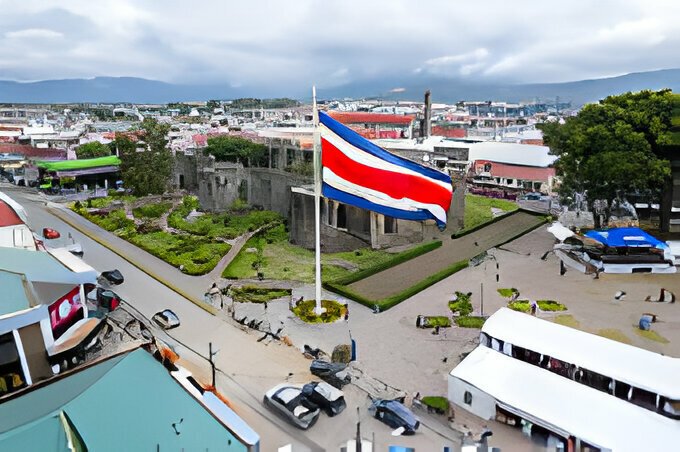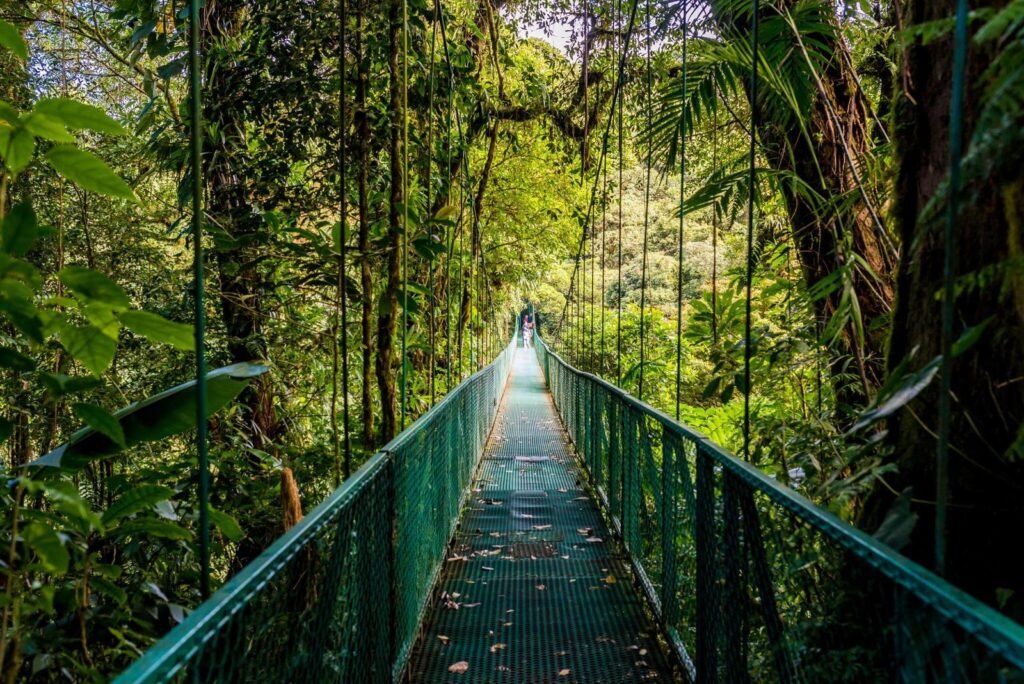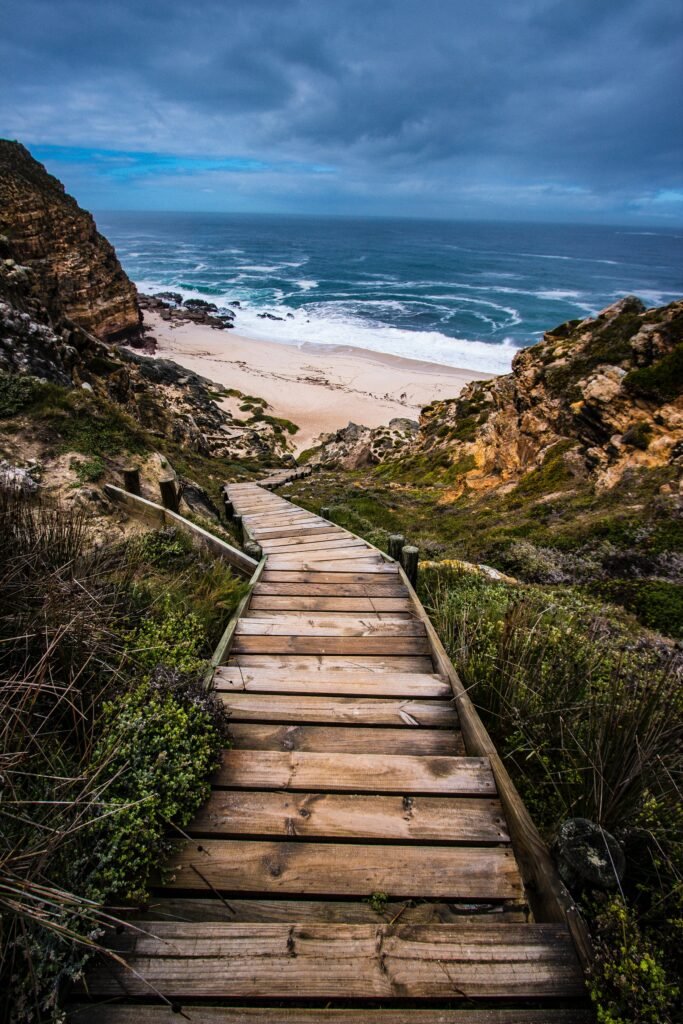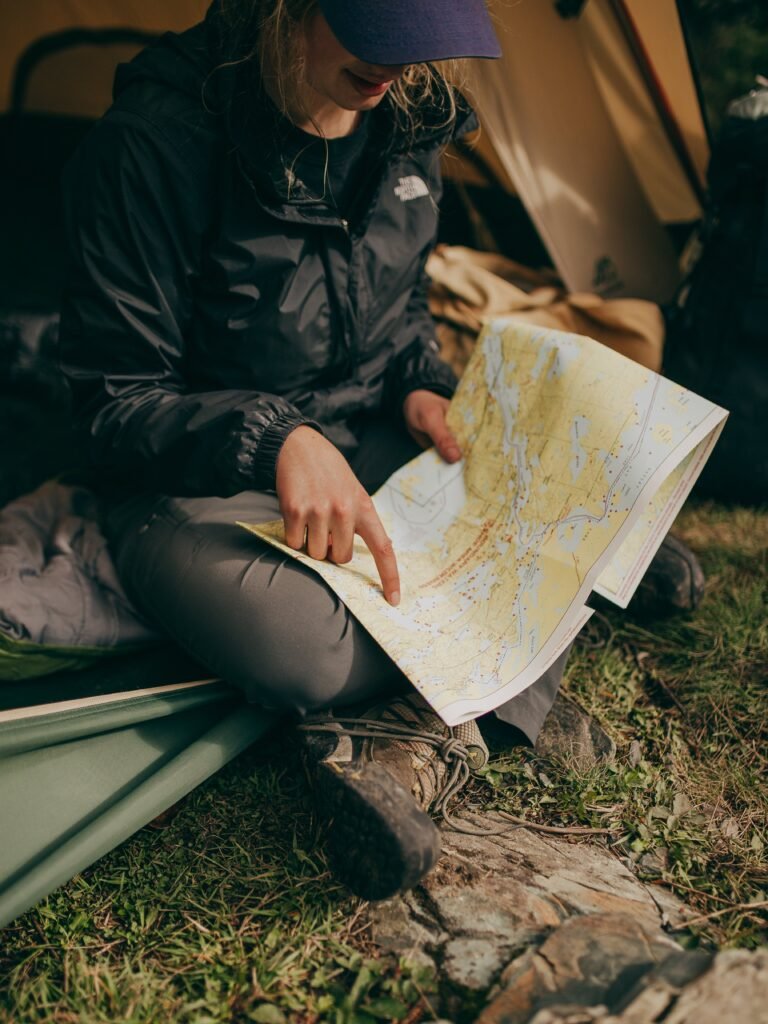Explore Costa Rica’s rainforests, volcanoes and beaches! Dry season (Dec-April) is ideal for outdoor adventures, but expect crowds. Rainy season (May-Nov) offers budget-friendly travel with quick afternoon showers. Pack light clothes, rain gear, sunscreen and sturdy shoes for hiking. Hike, bike, surf, or visit museums and relax on the beach. Pura vida! (translates to pure life)
Costa Rica is by far and large the most popular tourist destination in Central America. Over 80% of visitors come from the United States and in 2023 there were over four million visitors coming to Costa Rica. The country is small it’s only the size of West Virginia but don’t be fooled by its diminutive size. It’s the most bio diverse country in the world.
Costa Rica is located in Central America and is bordered in the north by Nicaragua and in the south by Panama it’s got the Pacific Ocean on its west coast and on its East Coast it has the Caribbean Sea it’s divided into seven regions, San Jose Alajuela, Heredia, Cartago, Guanacaste, Punta Arenas, and Limón. The name Costa Rica derives from Spanish and it means rich coast because the first Spaniards who arrived in Costa Rica were greeted by natives who were wearing elaborate gold rings in their ears and noses.
Speaking of those original inhabitants archeologists have found evidence that shows habitation from humans over 10,000 years ago. In the 1500s Christopher Columbus stopped in Costa Rica on his final voyage and it became a colony of Spain but after that it was pretty much neglected the Spanish didn’t find the riches that they were looking for in Costa Rica so it became this kind of periphery in the Spanish colonial empire.

In 1821 Costa Rica followed Mexico’s lead and declared independence from Spain becoming a sovereign nation in 1824. Since then the country has evolved immensely it’s one of the leaders in conservation globally because of its biodiversity it’s also a leader in ecotourism and it’s one of the most amazing destinations in the Americas so let’s get into the tips.
Costa Rica beckons with its vibrant rain forests, majestic volcanoes, and dazzling coastlines. But before you pack your bags, here’s a sneak peek into what awaits you in 2024. Unforgettable Costa Rica awaits! Let these tips guide you towards a magical adventure.
Tip 1: Cost to visit COsta rica
Unfortunately, Costa Rica is not that cheap because it’s one of the safest countries in Latin America. It doesn’t have a standing army, and it has relatively low crime rates compared to its neighbors. It’s become the go-to destination for travelers primarily from the United States to go on vacation. Costa Rica’s popularity has translated into higher prices across the board, so if you’re trying to keep your costs low, then I would suggest avoiding the large group tours.
I’m talking about, like the ziplining canopy tours. ATV tours of things in nature now might be fun, and if you have the budget to allocate to that, then by all means go right ahead. Ziplining through the forest in the Costa Rican canopy is really cool, and you can see lots of wildlife, but it is expensive. Most bills when eating out, even at small restaurants, are going to include a 10% service tip and a 13% tax, but the good news is you don’t have to tip on top of that.
Also, for visiting most natural sights, you’re probably going to have to pay a small fee between ten and twenty dollars, usually for parking and security, so even if you’re rolling up on a waterfall in the middle of nowhere, someone has set up a small business that has a parking lot, and you’re going to have to pay for parking, which is also essentially like a security charge. You pay for that so that the security guard keeps your car and your belongings safe while you are bathing.
Are you planning your first trip to Puerto Rico and looking for the perfect itinerary?
TIP 2: Best time to visit COsta rica
The low season in Costa Rica is April to December. This is the rainy season in the country. Costa Rica doesn’t have four seasons like temperate places in the northern and southern hemisphere because Costa Rica is very close to the equator. It only really has two seasons: the rainy season and the dry season.
I visited both in the dry and in the rainy season. It rains almost daily, but typically in short bursts like afternoon showers. Essentially, in the rainy season, it’s going to rain pretty much every single day, but these are small for the most part tropical storms that get a little bit of rain, maybe in the morning, and then clear out by the afternoon for a nice sunset. This creates dramatic scenery and lush landscapes. It does make for very dramatic photos during the rainy season.
The dry season is much drier, it’s much dustier, and it’s hotter, so I have visited in both the wet and the dry seasons. Personally, I prefer to visit during the low season during the rainy season. If you are going to visit during the rainy season, I highly recommend avoiding the month of October, which is the rainiest month of all. Avoid October if you can, because October is the wettest month.
Tip 3: Accommodation in COsta rica
Costa Rica has the wide range of accommodations, from little family-run bed and breakfasts to large international global chains. I’ve stayed in many small, family-run hotels right on the beach; these are great options. I highly recommend that if you’re trying to go surfing, visit my friends over at Surf Inn Hermosa at Playa Hermosa Beach. But the last time that I visited my fiancée and I stayed in an Airbnbs down in the south of the country in multiple different Airbnbs, and that was the most gratifying way for me personally to travel. So choosing sites that aren’t on everybody’s list is really going to help you save money on your accommodation.
TIP 4: Transportation in COsta rica
Rent a car. Absolutely essential Costa Rica does not have great public transportation, pretty much just buses, and the roads are very windy and can be quite dangerous, so rent a car. I highly recommend you get insurance because drivers in Costa Rica, especially truck drivers, drive quite aggressively on single-lane narrow roads with twists and curves and cliffs.
They also do not speed because there are speed traps all over the place. The police in Costa Rica are well aware that there are many travelers who have rented cars who might be going a little bit fast, and therefore you will get pulled over. You will have to pay a small fine, which is kind of essentially a bribe to be let go and let on your wet drive the speed limit. Stay super alert and be careful when you are passing cars.!
Tip 5: Weather in COsta rica
Get prepared to be wet. Even in the dry season, it does rain occasionally. It is a tropically lush country, and that is due to the amount of rain that it receives, but even when it’s not raining, it can be extremely humid, so wear clothes that breathe well, like linens or synthetic materials.
Having clothes that dry quickly that wick moisture and that breathe is very important, as is bringing a light shell rain jacket to keep you dry when it does rain. Mornings tend to have the best weather as well, so if there’s something that you’re trying to do, like a hike where you’re going to be active and sweating, I highly recommend that you do that towards the beginning of the day.
TIP 6: Volcanoes in COsta rica
Costa Rica is a highly active volcanic region, and these volcanoes really do dictate the weather systems in the country, especially in the highlands. One of the benefits of volcanic activity are hot springs. And if you go to the town of Arenal, there are quite a lot of hot springs to choose from. The last time that I visited, I had the pleasure of staying in Tabacon Hot Springs Resort. This place is literally heaven on earth.
If you have a bit of a budget to splurge, I highly recommend staying there for at least a night. But you can also pay and get access to the Thermal River. It’s essentially a hot river that comes down through this beautiful jungle and you can soak. It’s just one of the most magical and fantastic hot spring experiences you will ever have.
So when you go to Arenal, do not miss out on the hot springs. Arenal is also one of the top ten most active volcanoes in the world, although it has been dormant for the last seven years. Don’t be alarmed if you smell sulfur, but definitely it’s worth Googling before you visit what the volcano is doing.
TIP 7: Wildlife in COsta rica
Costa Rica is one of the most biologically diverse countries on earth; it only takes up 0.03% of the Earth’s surface, but over 5% of the Earth’s species call Costa Rica home. Costa Rica is also leading the way in conservation in Central America. Over 25 percent of Costa Rica’s landmass is protected in national parks, which means for visitors, there’s over 100 protected wildlife areas to visit, so if you’re into bird-watching or just being out in nature, you’re quite literally spoiled for choice in Costa Rica.
Monkeys are the most common mammal, but be careful. Howler monkeys can be territorial and aggressive. You’ll probably hear their noise coming from the canopy; it sounds something like that, so when you hear that, you know it’s a howler monkey, not just like some angry ogre in the forest and also be aware that if a howler monkey is right above you, do not antagonize it because they do as monkeys do, which means sometimes they defecate in their hands and have been known to throw that defecation at you, so be careful. Howler monkeys do throw poop.
It’s also home to 52 different types of hummingbirds, and if you know how to say hummingbird in Spanish, Costa Rica is also home to over 750,000 different species of insects—that’s over three-quarters of a million different types of insects. It’s home to more than 10% of the world’s butterflies, so if you’re afraid of creepy crawlies, then definitely be aware that Costa Rica has a lot of bugs; they’re very big, and they do occasionally, from time to time, make their way into your hotel room.
There are mosquitoes, so make sure you bring a solid mosquito repellent and make sure that you bring that from home because that, along with sunscreen, is quite expensive in Costa Rica. It’s marked up a lot because locals don’t really buy either of those products; only gringos do, so the prices are quite inflated, but make sure that you’re putting that on your ankles, your wrists, and the back of your neck because mosquitoes definitely love gringo blood. One of the best ways to deal with the mosquitoes, though, is to wear long-sleeve, long-leg clothing.
Tip 8: Osa Peninsula in COsta rica
Lastly, I recommend visiting the Osa Peninsula if you can. It is quite literally the most biodiverse place on planet Earth. It’s very rugged. It’s quite an adventure to get there, but there are some very unique eco hotels out on the peninsula as well as a really good wave called Matapalo where you can stay and surf. It’s a journey to get there; it required us to cross a river on a floating barge, which was quite an adventure in itself. But it’s a beautiful region, and it is the most biodiverse place on earth, so if you’re into different animals and different plant species, then head to the Osa Peninsula.
Tip 9: Beaches in COsta rica
There are over 801 miles of coastline and over 300 different beaches to choose from any way you look at it. A trip to Costa Rica has plenty of coastline for you to explore and plenty of beaches for you to lounge and luxuriate at, and if you’re a surfer like myself, then you are spoiled for choice with waves.
Some of the best surf waves that I’ve experienced in Costa Rica are at Playa Hermosa, just outside of Jaco. Ollie’s Point and Witches Rock, which require a boat trip from Tamarindo, and then also in the south, Pavones, a mythical left point break that is kind of fickle; it doesn’t get swell very often, but when it does, it is an incredible wave, and I got very lucky this last trip to be able to catch it with a good swell. So there’s also the wave Matapalo on the Osa Peninsula, but there are plenty of waves to choose from in Costa Rica, both on the Pacific and on the Caribbean side.
Do I need a visa to enter Costa Rica?
This depends on your nationality. Check official sources for current requirements.
What currency is used in Costa Rica?
The colón (CRC) is the official currency, but US dollars are widely accepted.
Is it safe to drink the tap water in Costa Rica?
While generally safe in most areas, bottled water is recommended, especially near the coast.
What’s the best time to visit Costa Rica?
Dry season (Dec-April) is ideal for outdoor activities, but busier. Rainy season (May-Nov) offers good deals with quick afternoon showers.
What are some must-pack items for Costa Rica?
Light clothes, rain jacket, sunscreen, hat, sturdy shoes for hiking.
What are popular activities?
Hiking, biking, surfing, volcano and rainforest exploration, visiting beaches, cultural experiences.
What’s the local phrase to know?
Pura vida! which means “pure life” and reflects the laid-back Costa Rican attitude.
Is it expensive to visit?
Costs can vary depending on travel style. Luxury travel will be pricier, but budget-friendly options exist, especially during the rainy season.
Is it good for families?
Absolutely! With its abundance of nature, outdoor activities, and generally safe environment, Costa Rica is a great family vacation destination.



